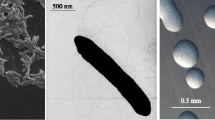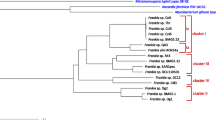Abstract
Two sequenced nodulation regions of lupin Bradyrhizobium sp. WM9 carried the majority of genes involved in the Nod factor production. The nod region I harbored: nolA, nodD, nodA, nodB, nodC, nodS, nodI, nodJ, nolO, nodZ, fixR, nifA, fixA, nodM, nolK and noeL. This gene arrangement resembled that found in the nodulation region of Bradyrhizobium japonicum USDA110, however strain WM9 harbored only one nodD gene copy, while the nodM, nolK and noeL genes had no counterparts in the 410 kb symbiotic region of strain USDA110. Region II harbored nolL and nodW, but lacked an nodV gene. Both regions carried ORFs that lacked similarity to the published USDA110 sequences, though they had homologues in symbiotic regions of Rhizobium etli, Sinorhizobium sp. NGR234 and Mesorhizobium loti. These differences in gene content, as well as a low average sequence identity (70%) of symbiotic genes with respect to B. japonicum USDA110 were in contrast with the phylogenetic relationship of USDA110 and WM9 revealed by the analysis of 16S rDNA and dnaK sequences. This most likely reflected an early divergence of symbiotic loci, and possible co-speciation with distinct legumes. During this process the loss of a noeI gene and the acquisition of a nolL gene could be regarded as an adaptation towards these legumes that responded to Nod factors carrying 4-O-acetylfucose rather than 2-O-methylfucose. This explained various responses of lupins and serradella plants to infection by mutants in nodZ and nolL genes, knowing that serradella is a stringent legume while lupins are more promiscuous legumes.
Similar content being viewed by others
References
Ausubel F.M., Brent R., Kingston R.E., Moore D.D., Seidman J.G., Smith J.A. et al. 1989. Current Protocols in Molecular Biology. John Wiley & Sons, New York.
Baev N., Endre G., Petrovics G., Banfalvi Z. and Kondorosi A. 1991. Six nodulation genes of nod box locus 4 in Rhizobium meliloti are involved in nodulation signal production: nodM codes for D-glucosamine synthetase. Mol. Gen. Genet. 228: 113–124.
Barrera L.L., Trujillo M.E., Goodfellow M., Garcia F.J., Hernandez-Lucas I., Davila G. et al. 1997. Biodiversity of brady-rhizobia nodulating Lupinus spp. Int. J. Syst. Bacteriol. 47: 1086–1091.
Berck S., Perret X., Quesada-Vincens D., Prome J., Broughton W.J. and Jabbouri S. 1999. NolL of Rhizobium sp. strain NGR234 is required for O-acetyltransferase activity. J. Bacteriol. 181: 957–964.
Bottomley P.J., Cheng H.-H. and Strain S. 1994. Genetic structure and symbiotic characteristics of a Bradyrhizobium population recovered from a pasture soil. Appl. Environ. Microbiol. 60: 1754–1761.
Carlson R.W., Sanjuan J., Bhat U.R., Glushka J., Spaink H.P., Wijfjes A.H. et al. 1993. The structures and biological activities of the lipo-oligosaccharide nodulation signals produced by type I and II strains of Bradyrhizobium japonicum. J. Biol. Chem. 268: 18372–18381.
Corvera A., Prome D., Prome J.-C., Martinez-Romero E. and Romero D. 1999. The nolL gene from Rhizobium etli determines nodulation efficiency by mediating the acetylation of the fucosyl residue in the nodulation factor. Mol. Plant-Microbe Interact. 12: 236–246.
Dobert R.C., Breil B.T. and Triplett E.W. 1994. DNA sequence of the common nodulation genes of Bradyrhizobium elkanii and their phylogenetic relationship to those of other nodulating bacteria. Mol. Plant-Microbe Interact. 7: 564–572.
Downie A.J. 1998. Functions of rhizobial nodulation genes. In: Spaink H.P., Kondorosi A. and Hooykaas P.J.J. (eds), The Rhizobiaceae. Molecular Biology of Model Plant-Associated Bacteria. Kluwer Academic Publishers, pp. 387–402.
Eckhardt M.M., Baldwin I.L. and Fred E.B. 1931. Studies of the root-nodule organism of lupines. J. Bacteriol. 21: 273–285.
Felsenstein J. 1993. PHYLIP (phylogeny inference package) 3.4c edit. University of Washington, Seattle.
Ferro M., Lorquin J., Ba S., Sanon K., Prome J.-C. and Boivin C. 2000. Bradyrhizobium sp. strains that nodulate the leguminous tree Acacia albida produce fucosylated and partially sulfated nod factors. Appl. Environ. Microbiol. 66: 5078–5082.
Freiberg C., Fellay R., Bairoch A., Broughton W.J., Rosenthal A. and Perret X. 1997. Molecular basis of symbiosis between Rhizobium and legumes. Nature 387: 394–401.
Galibert F., Finan T.M., Long S.R., Puhler A., Abola P., Ampe F. et al. 2001. The composite genome of the legume symbiont Sinorhizobium meliloti. Science. 293: 668–672.
Gillette W.K. and Elkan G.H. 1996. Bradyrhizobium (Arachis) sp. strain NC92 contains two nodD genes involved in the repression of nodA and a nolA gene required for the efficient nodulation of host plants. J. Bacteriol. 178: 2757–2766.
Gladstones J.S. 1998. Distribution, origin, and taxonomy, history and importance. In: Gladstones J.S., Atkins C.A. and Hamblin J. (eds), Lupins as Crop Plants: Biology, Production and Utilization. CAB International.
Göttfert M., Grob P. and Hennecke H. 1990. Proposed regulatory pathway encoded by the nodV and nodW genes, determinants of host specificity in Bradyrhizobium japonicum. Proc. Natl. Acad. Sci. USA 87: 2680–2684.
Göttfert M., Röthlisberger S., Kündig C., Beck C., Marty R. and Hennecke H. 2001. Potential symbiosis-specific genes uncovered by sequencing a 410-kb DNA region of the Brady-rhizobium japonicum chromosome. J. Bacteriol. 183: 1405–1412.
Innes R.W., Hirose M.A. and Kuempel P.L. 1988. Induction of nitrogen-fixing nodules on clover requires only 32 kilobase pairs of DNA from the Rhizobium trifolii symbiosis plasmid. J. Bacteriol. 170: 3793–3802.
Jabbouri S., Relic B., Hanin M., Kamalaprija P., Burger U., Prome D. et al. 1998. nolO and noeI (HsnIII) of Rhizobium sp. NGR234 are involved in 3-O-carbamoylation and 2-O-methylation of Nod factors. J. Biol. Chem. 273: 12047–12055.
Kaneko T., Nakamura Y., Sato S., Asamizu E., Kato T., Sasamoto S. et al. 2000. Complete genome structure of the nitrogen-fixing symbiotic bacterium Mesorhizobium loti. DNA Res. 7: 331–338.
Lamrabet Y., Bellogin R.A., Cubo T., Espuny R., Gil A., Krishnan H.B. et al. 1999. Mutation in GDP-fucose synthesis genes of Sinorhizobium fredii alters Nod factors and significantly decreases competitiveness to nodulate soybeans. Mol. Plant Microbe Interact. 12: 207–217.
Lerouge P., Roche P., Faucher C., Maillet F., Truchet G., Prome J.-C. et al. 1990. Symbiotic host-specificity of Rhizobium meliloti is determined by a sulphated and acylated glucosamine oligosaccharide signal. Nature 344: 781–784.
Loh J., Stacey M.G., Sadowsky M.J. and Stacey G. 1999. The Bradyrhizobium japonicum nolA gene encodes three functionally distinct proteins. J. Bacteriol. 181: 1544–1554.
Lopez-Lara I.M., van den Berg J.D., Thomas-Oates J.E., Glushka J., Lugtenberg B.J. and Spaink H.P. 1995. Structural identification of the lipo-chitin oligosaccharide nodulation of Rhizobium loti. Mol. Microbiol 15: 627–638.
Łotocka B., Kopcińska J., Borucki W., Stępkowski T., Świderska A., Golinowski W. et al. 2000. The effects of mutations in nodZ and nolL genes of Bradyrhizobium sp.WM9 (Lupinus) upon the nodule structure in Lupinus luteus. Acta Biol Cracov series Bot 42: 155–163.
Luka S., Sanjuan J., Carlson R.W. and Stacey G. 1993. nolMNO genes of Bradyrhizobium japonicum are co-transcribed with nodYABCSUIJ, and nolO is involved in the synthesis of the lipo-oligosaccharide nodulation signals. J. Biol. Chem. 268: 27053–27059.
Mergaert P., Van Montagu M. and Holsters M. 1997. The nodulation gene nolK of Azorhizobium caulinodans is involved in the formation of GDP-fucose from GDP-mannose. FEBS Lett. 409: 312–316.
Moulin L., Munive A., Dreyfus B. and Boivin-Masson C. 2001. Nodulation of legumes by members of the beta-subclass of Proteobacteria. Nature. 411: 948–950.
Ochman H., Elwyn S. and Moran N.A. 1999. Calibrating bacterial evolution. Proc. Natl. Acad. Sci. U S A 96: 12638–12643.
Perret X., Freiberg C., Rosenthal A., Broughton W.J. and Fellay R. 1999. High-resolution transcriptional analysis of the symbiotic plasmid of Rhizobium sp. NGR234. Mol. Microbiol. 32: 415–425.
Perret X., Staehelin C. and Broughton W.J. 2000. Molecular basis of symbiotic promiscuity. Microbiol. Mol. Biol. Rev. 64: 180–201.
Price N.P.J., Relic B., Talmont F., Lewin A., Prome D., Pueppke S.G. et al. 1992. Broad-host range Rhizobium species strain NGR234 secretes a family of carbamoylated and fucosylated, nodulation signals that areO-acetylated and sulphated. Mol. Microbiol. 6: 3575–3584.
Pueppke S.G. and Broughton W.J. 1999. Rhizobium sp. strain NGR234 and R. fredii USDA257 share exceptionally broad, nested host ranges. Mol. Plant-Microbe Interact. 12: 293–318.
Sadowsky M.J., Cregan P.B., Göttfert M., Sharma A., Gerhold D., Rodriguez-Quinones F. et al. 1991. The Bradyrhizobium japonicum nolA gene and its involvement in the genotypesystematics specific nodulation of soybeans. Proc. Natl. Acad. Sci. U S A 88: 637–641.
Sambrook J., Fritsch E.F. and Maniatis T. 1989. Molecular Cloning: A Laboratory Manual. 2nd edn. Cold Spring Harbor Laboratory Press, Cold Spring Harbor, NY.
Sanjuan J., Carlson R.W., Spaink H.P., Bhat U.R., Barbour W.M., Glushka J. et al. 1992. A 2-O-methylfucose moiety is present in the lipo-oligosaccharide nodulation signal of Bradyrhizobium japonicum. Proc. Natl. Acad. Sci. U S A 89: 8789–8793.
Scott D.B., Young C.A., Collins-Emerson J.M., Terzaghi E.A., Rockman E.S., Lewis P.E. et al. 1996. Novel and complex chromosomal arrangement of Rhizobium loti nodulation genes. Mol. Plant-Microbe Interact. 9: 187–197.
Scott K.F. 1986. Conserved nodulation genes from the non-legume symbiont Bradyrhizobium sp. (Parasponia). Nucleic Acids Res. 14: 2905–2919.
Spaink H.P., Okker R.J., Wijffelman C.A., Tak T., Goosen-de Roo L., Pees E. et al. 1989. Symbiotic properties of rhizobia containing a flavonoid-independent hybrid nodD product. J. Bacteriol. 171: 4045–4053.
Stacey G., Luka S., Sanjuan J., Banfalvi Z., Nieuwkoop A.J., Chun J.Y. et al. 1994. nodZ, a unique host-specific nodulation gene, is involved in the fucosylation of the lipooligosaccharide nodulation signal of Bradyrhizobium japonicum. J. Bacteriol. 176: 620–633.
Stępkowski T., Rudzińska A., Świderski M., Biesiadka J., Spaink H. and Legocki A.B. 1996. Cloning and sequencing of the nodulation functions from lupineBradyrhizobium European Nitrogen Fixation Conference and NATO Advanced Research Workshop Abstract P-C-2. 2nd edn. pp 114.
Streeter J.G. 1995. A new model for the rapid effects of noninvasive treatments on nitrogenase and respiratory activity in legume nodules. J. Theor. Biol. 174: 441–452.
Stróżycki P. and Legocki A.B. 1988. Isolation and characterization of root nodule proteins from lupin. Acta Biochim. Pol. 35: 39–50.
Thompson J.D., Gibson T.J., Plewniak F., Jeanmougin F. and Higgins D.J. 1997. The CLUSTAL-X windows interface: flexible strategies for multiple sequence alignment aided by quality analysis tools. Nucleic Acids Res. 25: 4876–4882.
Turner S.L. and Young J.P. 2000. The glutamine synthetases of rhizobia: phylogenetics and evolutionary implications. Mol. Biol. Evol. 17: 309–319.
Ueda T., Suga Y., Yahiro N. and Matsuguchi T. 1995. Phylogeny of Sym plasmids of rhizobia by PCR-based sequencing of anodC segment. J. Bacteriol. 177: 468–472.
van Berkum P. and Eardly B.D. 1998. Molecular evolutionary systematics of the Rhizobiaceae. In: Spaink H.P., Kondorosi A. and Hooykaas P.J.J. (eds), The Rhizobiaceae. Molecular Biology of Model Plant-Associated Bacteria. Kluwer Academic Publishers, pp. 1–24.
Vincent J.M. 1970. A Manual for Practical Study of the Root-Nodule Bacteria. Blackwell Scientific Publications, Oxford.
Weisburg W.G., Barns S.M., Pelletier D.A. and Lane D.J. 1991. 16S ribosomal DNA amplification for phylogenetic study. J. Bacteriol. 173: 697–703.
Young J.M., Kuykendall L.D., Martinez-Romero E., Kerr A. and Sawada H. 2001. A revision of Rhizobium Frank 1889, with an emended description of the genus, and the inclusion of all species ofAgrobacterium Conn 1942 and Allorhizobium undicola de Lajudie et al. 1998 as new combinations:Rhizobium radiobacter, R. rhizogenes, R rubi, R undicola and R. vitis. Int. J. Syst. Evol. Microbiol. 51: 89–103.
Author information
Authors and Affiliations
Corresponding author
Rights and permissions
About this article
Cite this article
Stępkowski, T., Świderska, A., Miedzinska, K. et al. Low sequence similarity and gene content of symbiotic clusters of Bradyrhizobium sp. WM9 (Lupinus) indicate early divergence of “lupin” lineage in the genus Bradyrhizobium . Antonie Van Leeuwenhoek 84, 115–124 (2003). https://doi.org/10.1023/A:1025480418721
Issue Date:
DOI: https://doi.org/10.1023/A:1025480418721




